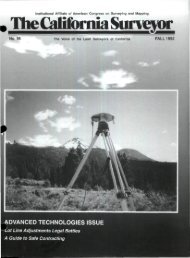P - CLSA
P - CLSA
P - CLSA
You also want an ePaper? Increase the reach of your titles
YUMPU automatically turns print PDFs into web optimized ePapers that Google loves.
Developing Efficient Survey Techniques<br />
James K. Crossfield, Ph.D<br />
Associatie Professor, Department<br />
of Civil and Surveyng Engineering,<br />
California State University, Fresno,<br />
Fresno, CA 93740<br />
(Continued from Spring Issue)<br />
The Real Property Connection<br />
Perhaps the most significant driving<br />
force behind the burgeoning<br />
number of computerized land information<br />
systems is the lure of<br />
avoiding duplication and waste by<br />
having one department or agency,<br />
rather than several, create and<br />
maintain the maps and related land<br />
records information. Efforts to keep<br />
costs down in such new systems<br />
often lead to development of quickfix,<br />
spatially imprecise systems that<br />
satisfy only some of the system requirements.<br />
More precise spatial requirements<br />
for future large scale<br />
mapping, land ownership records,<br />
or engineering design requirements<br />
are often not attainable in this<br />
scenario. Thus, a system that cannot<br />
avoid redesign may not have<br />
avoided duplication.<br />
The term "spatial imprecision,"<br />
as used here, is a measure of the<br />
distance between the location of a<br />
point as recorded in the computer<br />
and the location of that point on the<br />
ground. Unfortunately, most computerized<br />
land records information<br />
systems disregard spatial precision<br />
in their mapping applications by using<br />
one or more of the following<br />
techniques:<br />
1. "Rubber sheeting" to stretch<br />
and/or distort map data;<br />
2. Arbitrary elimination of apparent<br />
overlaps and gaps that<br />
are fully documented as existent<br />
in written legal records;<br />
3. Digitizing maps of unknown<br />
reliability to create computer<br />
map data having an even<br />
greater lack of spatial precision.<br />
Typical land records information<br />
systems create digitized boundary<br />
files from USGS IV2 minute<br />
topographic map sheets and existing<br />
assessors' maps. The positional<br />
uncertainty of any USGS<br />
map point is typically about 40',<br />
while the typical assessor's map<br />
contains about 10' of spatial im-<br />
FAST FINDING<br />
Locates steel objects:<br />
well casings, cast iron<br />
water lines, valve boxes,<br />
masonry nails, manhole<br />
covers, surveyor's markers<br />
and gas lines.<br />
• New state-of-the-art meter<br />
• Audio and visual readouts<br />
• Continuous one-tube<br />
construction<br />
• Ultra-light 2V& lb.<br />
• Built-in battery charger<br />
• Uses regular C-cell batteries<br />
• Battery condition meter<br />
• Fast battery changing<br />
• Rugged construction<br />
• Solid state electronics<br />
For CST5 new, complete<br />
56-page catalog.<br />
.:i<br />
ObA<br />
FT-60<br />
Mfr. List $525<br />
Audiovisual<br />
Locator<br />
iiiiHTri<br />
Chicago Steel Tape<br />
Dept-CSR, 450 Cips St.. P.O. Box 359<br />
Watseka, IL 60970 • (815)432-5237<br />
Exclusive Canadian Distributor<br />
Norman Wade Co., Ltd.. 75 Milner<br />
Scarborough, Ontario. CANADA MIS 3R7<br />
{416) 291-4211<br />
precision at every map point. Public<br />
decisions about private propertj^^<br />
rights should not be made when th^^^<br />
spatial uncertainty of the system<br />
may be larger than some owners'<br />
properties. A sample survey conducted<br />
in Spring 1985 by surveying<br />
students at California State University,<br />
Fresno, found that property<br />
owners were tolerant of no more<br />
than a one-half foot error in the location<br />
of their boundary lines.<br />
The following list summarizes<br />
several important facts associated<br />
with the increasingly popular computerization<br />
of land records information<br />
systems:<br />
1. Modern computerized land<br />
records information systems<br />
are necessary so that society<br />
can correctly and quickly<br />
answer fundamental questions<br />
about public and private<br />
rights and responsibilities to<br />
land.<br />
2. The common thread linking all<br />
types of environmental,<br />
resource, and ownership<br />
aspects of land is the<br />
geographical location of thesj^^<br />
items on the ground. Thos^^<br />
who deal with ground coordinates<br />
on a daily basis are the<br />
individuals who must provide<br />
guidance for the development<br />
of spatially reliable computerized<br />
land records information<br />
systems.<br />
3. Modernized land records information<br />
systems must be<br />
designed from the ground up<br />
with positional data of known<br />
quality used to create each<br />
new overlay of information.<br />
4. The spatial reliabihty of all<br />
data sets must be known at all<br />
times so that land ownership<br />
rights and responsibilities are<br />
not incorrectly determined<br />
because of imprecise information.<br />
Fundamentally, then, the<br />
cadastral overlay portion of<br />
multipurpose land information<br />
systems must be designed to include<br />
the spatial and written components<br />
of the entire collection of<br />
deed, abstract, and land survei^<br />
records relative to each parcel c^B<br />
land. To do less would run counter<br />
to long-estabUshed common law<br />
(Continued on page 8)<br />
Page 6 The California Surveyor — Summer, 1986
















